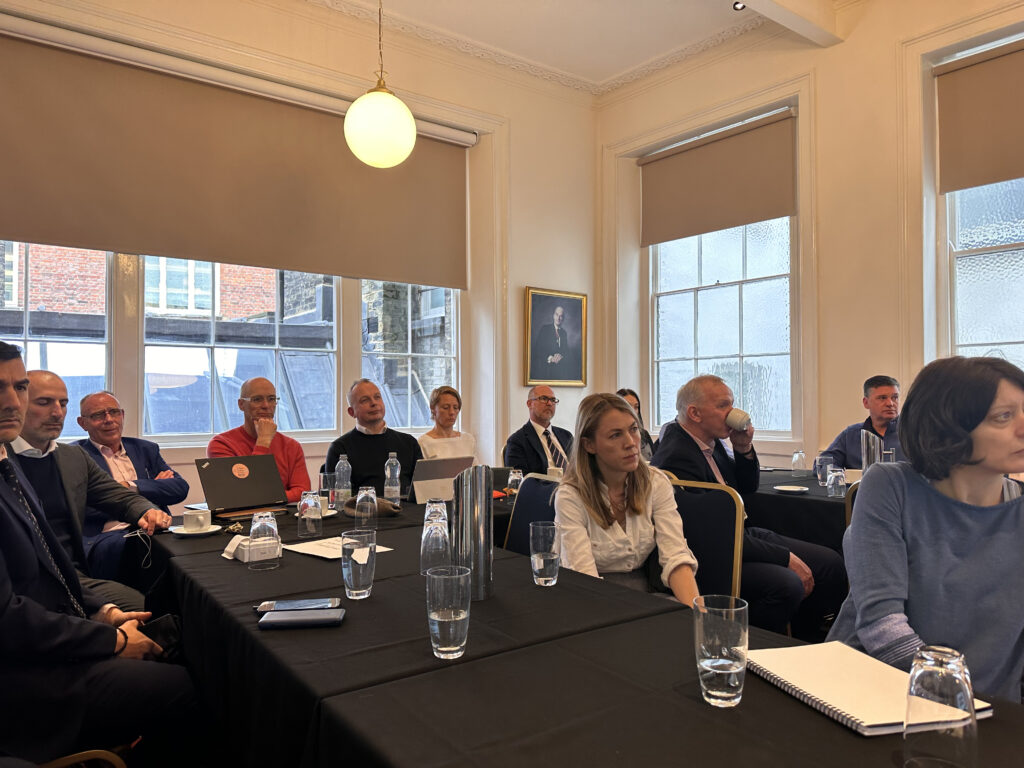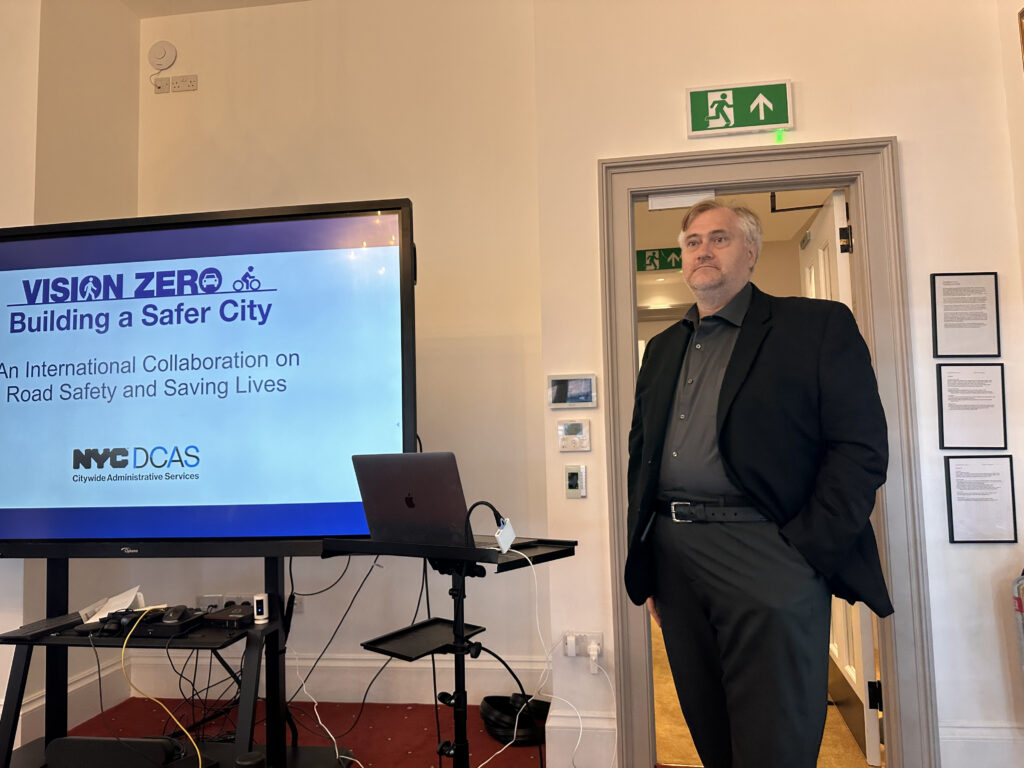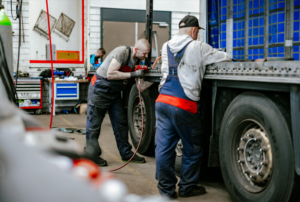Road safety is a challenge that requires a collaborative solution that recognises that policy does not develop in a vacuum, that drivers need both training and support and that, done right, safety policies can also be sustainability policies, agreed participants at the Fleet Vision International Collaboration on Road Safety roundtable on 26 April 2023, held at the Carmen Livery in London. FVI reports.
NYC’s Deputy Chief Fleet Management Officer Eric Richardson opened the roundtable by providing New York’s perspective on road safety and the city’s progress towards Vision Zero. He started with some stark facts. In 2022, 42,795 people died from collisions on US streets. Globally, there are 3,700 road deaths every day. ‘Far too many consider this acceptable, but that’s the equivalent of 10 planes crashing daily. Would that be acceptable?’
He explained that NYC has adopted the Safe System Approach to road safety and suggested this should be adapted globally. This holistic approach takes in safer roads, safer people, safer speeds, safer vehicles and post-crash care and requires a culture change to make safety the primary consideration for road system investment decisions. ‘We have to stop seeing incidents as “accidents”,’ said Eric. ‘They are crashes, and they are preventable.’
Eric went on to outline some of NYC’s strategies aimed at achieving culture change, including publicity campaigns such as the ‘New York Twist’ advert to highlight the importance of checking for cyclists before opening vehicle doors, outreach to communities in their own language, safe fleet transition plans based on data and evidence – for example, using technology to slow vehicles to the speed limit via intelligent speed assistance, making truck sideguards a requirement for all new trucks, enhanced use of vehicle telematics, and participating in the Truck of the Future pilot with Together for Safer Roads and VisionTrack. This uses technology for in-cab driver alerts, video telematics, and pedestrian turning alarms to mitigate the issues with conventional design trucks and obstructed views.
In closing, Eric articulated the global road safety challenge – that being safe on our roads should not be dependent on where you live, your income, or local regulations, and that basic safety systems such as seat belts, airbags, and proper crumple zones should be standard across the board in all countries no matter what local regulations call for. He argued that vehicle safety should address not only those inside the vehicle but also vulnerable road users. Finally, he said: ‘We have to build partnerships to solve the problem. We cannot do this alone, which is why we are here today at Fleet Vision International.’
Driver training
Ian Bourton, Head of Fleet Operations at Ubico, asked whether NYC has a driver training programme. Eric explained that the city has a defensive driving programme that covers the basics, including the state-authorised class and a presentation on city fleet rules and road safety, and that agencies provide various driver training on specific equipment. The city also uses telematics to identify behaviours that can lead to collisions, such as speeding.
‘When we train people to do their jobs safely, we should include how to safely drive their vehicles as part of it, and that is something we should all do,’ said Eric.
Kate Cairns, Founder of the See Me, Save Me campaign, instigator of CLOCS, and speaker, trainer and advisor on road risk management, pointed out that speed is irrelevant when HGVs are involved. ‘If you’re hit by a 32-tonne truck, you will die at 2mph.’ She added that one of the most effective safety training strategies is to give drivers the opportunity to experience the road from the cyclist’s perspective. ‘If you get a truck driver onto a bike, they realise what it’s like. There is nothing like the fear of being on a bike near a 32-tonne vehicle. Nearly 90% of drivers who did this training said they drove differently afterwards.’
Enforcement of dangerous driving, such as speeding, is also an issue in unexpected ways following the pandemic, according to Gregg Spotts, Director of the Department of Transportation in Seattle. He said the city is in the grip of a ‘reckless driving epidemic’ due to changing commuter and traffic patterns since lockdowns. ‘Seattle is the top city for home working in the US. On a given weekday, we have fewer than 50% of office workers at their desks, and more of those coming to work are driving rather than using transit. At the same time, we have a shortage of 300 police officers, so there is not much proactive traffic enforcement, and the drivers know it.’
In response, Seattle is looking at broader automatic enforcement, but this has raised equity concerns from the public of disproportionate enforcement, particularly in BIPOC communities where many incidents take place. The city is also using cameras to monitor dedicated bus lanes, which are being used by car drivers to pass other vehicles. ‘We have found that if we send a driver a warning, only 15% of people do it again.’
He added that there is a proposal to allocate the revenue from this kind of enforcement towards street safety or the neighbourhood where the offence occurred to negate the idea that the city is using enforcement simply to generate revenue.
Jason Ross, Compliance and Safety Manager from Transport for London said London is encouraging people to share space on the road rather than to compete for it. ‘And this is having an impact.’ Meanwhile, Ian Bourton suggested that more can be done by being proactive with technology. ‘We target drivers with poor behaviours. If drivers are going too fast by cyclists, for example, we can identify them using telematics and direct training towards these higher-risk drivers.’
However, Adam Christopher from ATT pointed out that you can’t address driver behaviour in isolation. ‘How much work do you do with the people who put the drivers to work? They are often under huge pressure to get deliveries done, and I don’t think enough attention is paid to this.’
Eric said NYC is addressing this by working with private industry to assist in training the drivers using the same tools used to train city drivers. Meanwhile, Peter Goldwasser explained that Together for Safer Roads has developed a programme specifically geared towards small/medium fleets that lack the resources for in-house training. He added that shifting to greener last-mile delivery options can also impact safety. ‘Research shows that eCargo bikes are just as effective as well as being safer.’
‘The driver is just the point of the inverted triangle of pressure,’ said Kate Cairns. ‘It is not just about one driver in one moment in one day causing a catastrophe. It is much more to do with the culture and the pressure they are under. I felt sorry for the driver who killed my sister and who went on to kill another pedestrian because of the systemic failure within our industry to train and protect our drivers and the public.’
Making it personal
If crashes have a huge negative impact on drivers, training can be positive, said Nick Laister, Immediate Past Master Carmen from the Worshipful Company of Carmen. ‘When I owned a transport business, we started a defensive driver training programme. Our older drivers were resistant at first; then one came to me after the course to say thank you. He was driving with his wife at the weekend, and it was the first they hadn’t argued about his driving.’
Joy Laister added that making things personal is a big part of making a difference. ‘We all have a personal story. We need to use those in our training. You will change people with your personal stories.’
‘We talk about real situations and real stories in our training,’ said Eric. ‘We do this so people understand that these are not just numbers. They are tragedies that happened to people, to drivers, to families. We also incorporate personal stories from our road safety advocate partners, such as Families for Safe Streets, so our drivers understand the importance of road safety.




Air quality
Road safety isn’t just about collisions, however, as Jason Airey, co-founder of WCRAQ, pointed out. ‘Statistically, air pollution from emissions has the biggest impact on cyclists and pedestrians. Should this be included in Vision Zero? More than 30,000 people die each year in the UK from air quality issues. One child dies every week from asthma caused by air pollution.’
‘There is a lot of synergy between sustainability, air quality and safety,’ agreed Eric. ‘As we electrify our vehicles, we can also make them safer. This is an exciting time for road transport because we have an opportunity to move things forward, but we are also out of time. We need to act now to tackle all these issues.’
‘If we plan logistics, we can take vehicles off the roads, which plays into sustainability,’ Kate pointed out. ‘I’ve just been to a project in Norway to assess its sustainability, and they had cargo bikes scooting around the construction site – it was brilliant.’
‘In California, cities are piloting zero emission delivery zones by making kerb space available only to smaller, electrified vehicles,’ said Greg. ‘DOTs are realising that they control the kerb, and there are now federal grants to enable cities to digitise kerb space and decide how to allocate it, so we are heading to a world where we can support these drivers and incentivise low-emissions deliveries.’
Pedestrian fatalities
Gordon Sutherland, Traffic and Road Logistics Manager at Tideway, pointed out that more pedestrians are killed by HGVs than cyclists. He asked Eric whether, because ‘jay walking’ is technically illegal in New York, there are fewer pedestrians killed on the roads in NYC than in the average western city. Eric said the city is seeing fewer pedestrian fatalities but that this is down to a combination of factors, including redesigning roads, speed bumps and lowering speed limits. ‘Enforcement is focused on dangerous driving behaviour because a pedestrian crossing the road isn’t going to kill someone.’
‘It’s a tricky question because there is a political element to transport policy,’ said TSR’s Peter Goldwasser. ‘It doesn’t happen in a vacuum – there’s messaging and politics and buy-in. What is the best way to drive safely? Is it enforcement? There is only so much you can do with enforcement, but redesign the roadway, and you make it safer all the time.’
Gregg said that transit systems are not optimised for pedestrians, and this means more jaywalking. ‘If you tell pedestrians to wait their turn, but the turns are all organised for the benefit of motorists, you will get a lot of dangerous behaviour.’
Safer vehicle design and Truck of the Future
London has the Direct Vision standard, but in the US, it is still challenging to find high-vision cabs. The Truck of the Future programme attempts to mitigate this problem using technology, said Eric. ‘We are doing everything we can with technology and camera systems to help drivers and provide fleet managers with feedback. We can retrofit trucks to make them safer.’
FVI Editor Ann-Marie Knegt asked why few US manufacturers have picked up safer cab designs, and Eric agreed it is a challenge. ‘The industry as a whole has a production crisis, and we need economies of scale. If we can get more fleets to require high-vision vehicles, manufacturers will make the change. That’s why NYC is constantly talking about this. We are trying to change the culture that favours “traditional design” over safe design.’
Jason Airey argued that design issues go further than the fact that trucks designed for motorways are not necessarily suitable for urban environments. ‘As we talk about sustainability, electric vehicles are better for urban roads and hydrogen for motorways, and maybe we are reaching the point where the whole transport system is configured in a different way instead of using one vehicle to do all things.’
Culture of change
Gordon from Tideway pointed to the power of proof of concept for new designs to gain acceptance from operators, describing how Tideway debunked objections to the use of low-entry cabs on construction sites. ‘We proved the concept so industry could see it worked. Yes, there is a higher capital cost, but this will come down as demand increases.’
‘If you get a driver in one of these vehicles, they love it, and they tell their friends and their colleagues,’ said Eric. ‘In the UK, you changed the culture. Now we need to do the same in the US.’
In closing, Ann-Marie Knegt said: ‘Safety is personal. It is personal for drivers, for victims, and for operators. When an accident happens, it becomes a personal issue. It is clear there are strong synergies between the US and the UK. We can and have learned from each other and will continue to do so. And there are also strong synergies between safety and sustainability. We can strengthen one to strengthen the other. And we can do it together.’



